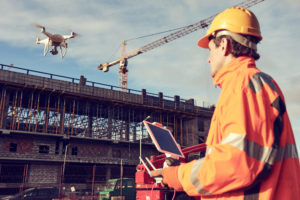
Drones have proven themselves incredibly valuable in the construction industry. In this three part series we will discuss recent changes in FAA regulations, drones’ current and future uses, and how drones could impact mechanics liens.
With the new FAA regulations, rules on drone use in commerce have been seriously loosened. As a result, we can expect drones to be utilized in a multitude of industries. Managers can be slow to adopt new technology, but the construction industry is one that will greatly benefit. Despite pretty narrow current restrictions, some actors in the construction industry are already deploying drones on construction projects. This post will serve as an introduction on how drones are already being used in construction, how they might be utilized when the new regulations go into effect, and how advances to drone technology might affect construction sites in the future.
Current Uses for Drones in Construction
It’s easy to envision utilizing drones for a multitude of uses. Companies like Skycatch are already using drones to map construction projects with extreme accuracy. Others are combining innovative software with drone technology to create 3D mapping complete with color and all. Even the NBA’s Sacramento Kings have embraced drone technology on the construction of their new stadium.
One of the most obvious benefits of using drones in construction would be increasing the accuracy of site mapping. As mentioned with Skycatch, drones have the ability to provide incredible accuracy when mapping a project. While aerial imaging is commonplace throughout the industry, the ease and mobility of drones provides an opportunity to create a detailed map of a project on short notice. Drone imaging can also be done in-house if an employee is licensed to fly small unmanned aircrafts. With 3D printing technology, a company could even create a physical model of the construction site, which could be a valuable service for property owners and contractors alike.
Drones are effective in monitoring job sites. In Sacramento, drones are used daily to track the progress of the stadium project. An individual worker’s activity can even be tracked. Once a day, drones capture images of the site and translate them into digital 3D models. The software used by the Kings’ drone operators, ImageInFlight, allows managers to see how subcontractors are working together. The models are then compared to construction plans, allowing project managers to better understand the progress of the project and to identify issues.
Future Uses
Let’s start simply and slowly work our way toward borderline sic-fi uses for drone technology.
Delivery
The new FAA regulations allow for drone delivery, so long as the load is securely attached and the total weight remains under 55 pounds. This means that drones could be used to transport small tools and supplies. Other new regulations would also limit these deliveries. For example, drones may not be flown over nonparticipating parties and must remain within the operators line of sight, restricting the value of drone delivery. Other limitations also apply, but this certainly does not eliminate the usefulness of drones in construction.
If you look ahead to the future, it is likely that the FAA will again loosen regulations as drone technology improves. Deliveries over greater distances and heavier payloads will likely become available, and hot shot deliveries for construction sites could become lightning fast by using drones.
Green Building
It appears there are more opportunities to utilize drones for imaging as well. Siemens recently used drones equipped with thermal imaging cameras to identify energy loss, which could be invaluable in green construction. By utilizing this technology, it would be infinitely easier to track the energy efficiency of green projects. The imaging Siemens is utilizing can identify “thermal radiation, liquid and gas losses, areas with poor insulation, and spots with heavy moisture.”
Imaging and Inspections
In Australia, an aerial imaging company and engineering consultants have joined forces to utilize drones in plant inspections. By using drones, plant audits could become exponentially safer. These audits can also be conducted with minimal interference to plant operations, which would certainly be embraced by plant managers.
Replacing Cranes(!?)
One of the most interesting, and accordingly most distant, potential use of drones is to replace or assist cranes. Before you scoff at the idea, watch “Construction with Quadrotor Teams” and consider the leaps in drone technology that we have already seen. How cool was that? Drones are not currently powerful enough to do the work that cranes do, but the potential is there. While it will be years before drones are capable of lifting a useful amount of material, it is much more foreseeable that drones could provide assistance to cranes in the very near future. Drones are capable of nimble movement and could help when precision is imperative. With drone atomization on the horizon, this might all be done without a manual operator.
Takeaway
I could drone on and on about this subject (pun very much intended), but the message is clear: drones will be a huge asset in construction going forward. Drones will help with mechanics liens and bond claims, too. Look out for our next post in the series, “Drones in Construction: Drones and Mechanics Liens.”


